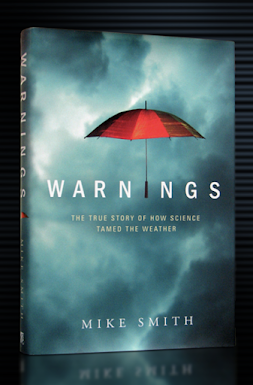A Perfect Book For Spring
The next seven months are "storm season:" now for tornadoes and, starting May 15, for hurricanes.
Warnings: The True Story of How Science Tamed the Weather is very much a people story -- of courageous meteorologists who bet their careers to discover and implement the science needed to save thousands of lives every year. |
| From B&N |
Goodreads.com is full of tough reviewers; here is a review from Goodreads...
I picked this book up when I was working on a journal piece dealing with storm shelter access in tornado-vulnerable regions of the country. While I used it for my research, I never sat down and just read it from cover to cover with no need. May 3, a date personal to me and my history with weather, came around, and I picked the book up to read in its entirety and in the order presented. All in all, I enjoyed the ride. While there are some moments in the middle where the science gets a little dry, but the emotions and storytelling connected to the major weather events selected by the author more than make up for those dips.
Keeping in mind his audience, while this book could have been much longer, and more issues discussed could have been told with greater detail, Smith strikes a good balance of providing the necessary facts while holding the reader's attention. The sprinkling of human touches throughout the science makes the book intelligent and a bit emotional (but full disclosure: I am emotional at all tornado stories!).
Smith has a huge arsenal of weather events to describe, and he chooses carefully. Some tornadoes are those that affected him personally, but some events, particularly the hurricanes, are life-changing events in the history of storm prediction. In particular, his account of the numerous failings around Hurricane Katrina, committed by everyone except the meteorologists, is well done. Obviously, he cannot get into the many layers of problems before, during, and after Katrina, but his job is not to address all of those. He simply has a few chapters to discuss the science and remind the reader that the best science in the world can't overcome horrible bureaucracy.
The book ends beautifully by demonstrating how far we've come with forecasting and the ability to save lives, the foundation of all forecasting work. Smith chooses the ferocious Greensburg tornado to show how the advances in science have saved many lives. While the 1999 Bridge Creek-Moore tornado was perhaps even more of a celebration when comparing population to death toll, Smith makes good use of the facts around Greensburg to perfectly compare it to the earlier, much deadlier, yet otherwise very similar Udall tornado.
Smith has a lot to say in this area, and he says it well.
Keeping in mind his audience, while this book could have been much longer, and more issues discussed could have been told with greater detail, Smith strikes a good balance of providing the necessary facts while holding the reader's attention. The sprinkling of human touches throughout the science makes the book intelligent and a bit emotional (but full disclosure: I am emotional at all tornado stories!).
Smith has a huge arsenal of weather events to describe, and he chooses carefully. Some tornadoes are those that affected him personally, but some events, particularly the hurricanes, are life-changing events in the history of storm prediction. In particular, his account of the numerous failings around Hurricane Katrina, committed by everyone except the meteorologists, is well done. Obviously, he cannot get into the many layers of problems before, during, and after Katrina, but his job is not to address all of those. He simply has a few chapters to discuss the science and remind the reader that the best science in the world can't overcome horrible bureaucracy.
The book ends beautifully by demonstrating how far we've come with forecasting and the ability to save lives, the foundation of all forecasting work. Smith chooses the ferocious Greensburg tornado to show how the advances in science have saved many lives. While the 1999 Bridge Creek-Moore tornado was perhaps even more of a celebration when comparing population to death toll, Smith makes good use of the facts around Greensburg to perfectly compare it to the earlier, much deadlier, yet otherwise very similar Udall tornado.
Smith has a lot to say in this area, and he says it well.
Whether you want a "storm season book" or just a great book for spring vacation, if you like this blog, you'll really enjoy Warnings.
You can get your copy of Warnings at Barnes & Noble, Amazon and your local bookseller. If you enjoy reading this blog, you'll love Warnings.





Comments
Post a Comment